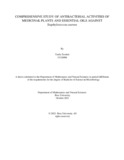| dc.contributor.advisor | Hossain, Mahboob | |
| dc.contributor.author | Tawhid, Tasfia | |
| dc.date.accessioned | 2021-12-02T05:42:40Z | |
| dc.date.available | 2021-12-02T05:42:40Z | |
| dc.date.copyright | 2021 | |
| dc.date.issued | 2021-10 | |
| dc.identifier.other | ID 15126006 | |
| dc.identifier.uri | http://hdl.handle.net/10361/15688 | |
| dc.description | This thesis is submitted in partial fulfilment of the requirements for the degree of Bachelor of Science in Microbiology, 2021. | en_US |
| dc.description | Catalogued from PDF version of thesis. | |
| dc.description | Includes bibliographical references (pages 35-40). | |
| dc.description.abstract | Recently it has been observed that an increasing number of bacteria are building resistance to synthetic antibiotics which hampers controlling infective health conditions. It’s familiar to everyone that most antibiotics no longer function; infections are getting worst or impossible to manage. It is time to discover a substitute for antibiotics from organic sources.
Medicinal plants are considered as the abundant bioresource of drugs for conventional medicines, food supplements, and chemical essence for artificial drugs. Nowadays, researchers are progressively focusing their consideration in investigating herbal products due to the higher resistance of microorganisms against the presently used antibiotics and pharmaceutical companies are seeking options for the costly production of synthetic drugs. Medicinal plants can be the method to alternate this condition as most of them are secure with minor side effects.
In the present work, ethanol and aqueous extracts of Neem (Azadirachta indica), Tulsi (Ocimum sanctum), and Pomegranate (Punica granatum) were impinged to microbial sensitive test using disk diffusion method. The microorganism occupied for this research was Staphylococcus aureus. The greatest and notable antibacterial activity (zone of inhibition) was noticed with ethanolic extract of Neem (Azadirachta indica) extract against Staphylococcus aureus (10mm) which is the most effective. No antimicrobial action was found with aqueous extracts of all the three medicinal plants against the chosen bacteria. However, three conventional antibiotics were employed as a positive control against the chosen bacteria which had demonstrated antimicrobial action.
Black cumin oil is familiar to have antibacterial activities and this study was intended to establish the abilities to manage the growth of some skin infection-causing bacteria and also compared the antimicrobial efficacy of Mixed herb oil, Sandalwood oil, and some standard antibiotics. This study of antibacterial activity against chosen pathogen was done by the Disk diffusion method and Agar well diffusion method. In most cases, the inhibition of bacterial growth after one day of incubation demonstrated better results. Mixed herb oil showed the best inhibition against the bacteria chosen for this research whereas Black cumin oil showed maximum and Sandalwood oil showed minimum inhibition against S.aureus. | en_US |
| dc.description.statementofresponsibility | Tasfia Tawhid | |
| dc.format.extent | 43 pages | |
| dc.language.iso | en | en_US |
| dc.publisher | Brac University | en_US |
| dc.rights | Brac University theses are protected by copyright. They may be viewed from this source for any purpose, but reproduction or distribution in any format is prohibited without written permission. | |
| dc.subject | Staphylococcus aureus | en_US |
| dc.subject | Essential oil | en_US |
| dc.subject.lcsh | Medicinal plants | |
| dc.title | Comprehensive study of antibacterial activities of medicinal plants and essential oils against Staphylococcus aureus | en_US |
| dc.type | Thesis | en_US |
| dc.contributor.department | Department of Mathematics and Natural Sciences, Brac University | |
| dc.description.degree | B. Microbiology | |

